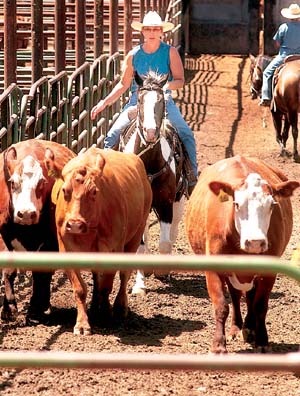
Though some ranchers across the country say the mandatory
national advertising campaign
”
Beef, It’s What’s for Dinner
”
infringes on their free speech rights, local cattle owners say
the small fee they pony up for advertising is worth it.
Though some ranchers across the country say the mandatory national advertising campaign “Beef, It’s What’s for Dinner” infringes on their free speech rights, local cattle owners say the small fee they pony up for advertising is worth it.
“It’s promoting the beef and that’s what’s selling it,” local cattle rancher Bill Roth said.
The U.S. Supreme Court agreed last week to look into the national beef campaign “Beef, It’s What’s for Dinner” and will rule if cattlemen should have to contribute funds for the campaign at all. Currently, cattle owners are required to pay $1 per cow to promote beef sales. Fifty percent of the money goes to the California State Beef Council for in-state advertising, and 50 percent goes to the U.S. Department of Agriculture (USDA) marketing program. The Supreme Court Justices will weigh whether the USDA’s ad campaign violates the cattle rancher’s free speech rights, since they’re forced to pay into the marketing campaign.
San Benito County Cattlemen’s President Jeannie Coefield said she’s spoken with a few ranchers who disagree with the advertising cost, but in her opinion, it’s for a good cause.
“There’s people who complain about it, but it’s helpful to the beef industry,” she said.
Complaints may be coming from ranchers who are trying to brand their beef in a niche market as being organic or grass fed and are concerned about paying into and being lumped in with all other ranchers in the mass campaign, but California Beef Council Executive Director Virginia Coehlo said that’s not the case.
“The ad campaign isn’t there to brand the meat, it’s there to raise awareness,” she said.
The generic advertising could grab someone’s attention whose getting ready for dinner and wants beef, but the consumer is still going to buy the brand they want, she said.
“One of the reasons beef consumption has gone up is because of the awareness,” she said. “The print ads have also promoted the nutritional value of beef, which is a good thing.”
San Benito County Brand Inspector Sally Miller said California cattle ranchers get double the advertising bang for their buck because not only does the national campaign promote them, but the state Beef Council airs commercials and radio ads as well.
“The California Beef Council targets a lot of urban areas like when you’re driving through Los Angeles and you hear a beef ad on the radio, so we’re getting extra coverage,” she said.
Regardless what happens in federal court, California’s cattle ranchers will continue to pay $1 per head. Coehlo said if the federal contribution is stopped by the courts, the beef council will keep 100 percent of the $1 and continue to use it for in-state advertising, but consumers may not see the national beef campaign, which has been running on television since 1986.
The current price for beef is 45 cents per pound, and the average cow can weigh anywhere between 1,000 to 1,400 pounds.
Roth, who has been raising cattle his entire life, said the $1 per cow is a small price to pay for the business it brings.









